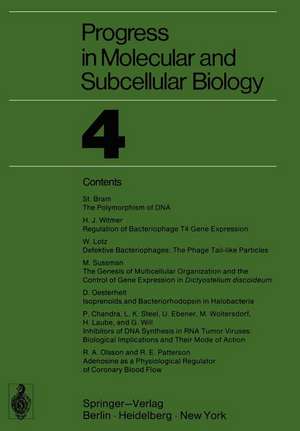Progress in Molecular and Subcellular Biology: Progress in Molecular and Subcellular Biology, cartea 4
Contribuţii de S. Bramen Limba Engleză Paperback – 15 noi 2011
Din seria Progress in Molecular and Subcellular Biology
- 18%
 Preț: 1115.46 lei
Preț: 1115.46 lei - 18%
 Preț: 1403.04 lei
Preț: 1403.04 lei - 18%
 Preț: 1112.30 lei
Preț: 1112.30 lei - 18%
 Preț: 1117.03 lei
Preț: 1117.03 lei - 18%
 Preț: 1222.49 lei
Preț: 1222.49 lei - 18%
 Preț: 1382.21 lei
Preț: 1382.21 lei - 18%
 Preț: 1232.26 lei
Preț: 1232.26 lei - 18%
 Preț: 1222.80 lei
Preț: 1222.80 lei - 24%
 Preț: 1045.93 lei
Preț: 1045.93 lei - 18%
 Preț: 956.50 lei
Preț: 956.50 lei -
 Preț: 387.20 lei
Preț: 387.20 lei - 15%
 Preț: 639.73 lei
Preț: 639.73 lei - 15%
 Preț: 633.19 lei
Preț: 633.19 lei - 15%
 Preț: 634.18 lei
Preț: 634.18 lei - 15%
 Preț: 634.00 lei
Preț: 634.00 lei - 15%
 Preț: 640.24 lei
Preț: 640.24 lei - 5%
 Preț: 714.27 lei
Preț: 714.27 lei - 15%
 Preț: 634.32 lei
Preț: 634.32 lei - 15%
 Preț: 637.28 lei
Preț: 637.28 lei - 15%
 Preț: 637.78 lei
Preț: 637.78 lei - 15%
 Preț: 637.28 lei
Preț: 637.28 lei - 15%
 Preț: 649.06 lei
Preț: 649.06 lei -
 Preț: 387.75 lei
Preț: 387.75 lei - 18%
 Preț: 1220.75 lei
Preț: 1220.75 lei - 18%
 Preț: 1224.99 lei
Preț: 1224.99 lei - 18%
 Preț: 946.87 lei
Preț: 946.87 lei - 15%
 Preț: 633.35 lei
Preț: 633.35 lei - 18%
 Preț: 944.36 lei
Preț: 944.36 lei -
 Preț: 387.96 lei
Preț: 387.96 lei - 15%
 Preț: 633.02 lei
Preț: 633.02 lei - 15%
 Preț: 640.88 lei
Preț: 640.88 lei - 5%
 Preț: 720.10 lei
Preț: 720.10 lei
Preț: 640.88 lei
Preț vechi: 753.97 lei
-15% Nou
Puncte Express: 961
Preț estimativ în valută:
122.67€ • 133.29$ • 103.11£
122.67€ • 133.29$ • 103.11£
Carte tipărită la comandă
Livrare economică 21 aprilie-05 mai
Preluare comenzi: 021 569.72.76
Specificații
ISBN-13: 9783642662515
ISBN-10: 364266251X
Pagini: 268
Ilustrații: XII, 256 p.
Dimensiuni: 170 x 244 x 14 mm
Greutate: 0.43 kg
Ediția:Softcover reprint of the original 1st ed. 1976
Editura: Springer Berlin, Heidelberg
Colecția Springer
Seria Progress in Molecular and Subcellular Biology
Locul publicării:Berlin, Heidelberg, Germany
ISBN-10: 364266251X
Pagini: 268
Ilustrații: XII, 256 p.
Dimensiuni: 170 x 244 x 14 mm
Greutate: 0.43 kg
Ediția:Softcover reprint of the original 1st ed. 1976
Editura: Springer Berlin, Heidelberg
Colecția Springer
Seria Progress in Molecular and Subcellular Biology
Locul publicării:Berlin, Heidelberg, Germany
Public țintă
ResearchCuprins
The Polymorphism of DNA.- I. Introduction.- II. A Summary of the Principles of DNA X-Ray Diffraction.- III. Generalities of DNA Transitions.- IV. B-like Structures.- V. The A Form.- VI. C-like Structures.- VII. Polynucleotide Polymorphism.- VIII. New Conformations of AT-rich DNA.- IX. Biological Relevance.- References.- Regulation of Bacteriophage T4 Gene Expression.- I. Introduction.- II. The Genetic Map of Coliphage T4.- III. Resolution of the Early and Late Classes of T4- specific RNA.- IV. Resolution of the Quasi-late RNA.- V. Immediate-early and Delayed-early RNAs.- VI. Transcription of the Prereplicative Genes of Bacteriophage T4: The Read-through Mechanism.- VII. Delayed-early Promoters.- VIII. The Interrelationship between Translation and Elongation of Chains from Immediate-early Promoters.- IX. Requirements for True-late Transcription.- X. Transcription of the Quasi-late Genes.- XI. Turn-off of Early Gene Expression.- XII. T4-specific Modifications of DNA-dependent RNA Polymerase.- XIII. T4-specific Modification of the Host Translational Machinery.- XIV. Expression of the Endolysin Gene of Phage T4.- References.- Defective Bacteriophages: The Phage Taillike Particles.- I. Introduction.- II. Structure.- III. Production.- IV. Bactericidal Activity.- V. Evolution.- VI. Conclusions.- References.- The Genesis of Multicellular Organization and the Control of Gene Expression in Diotyostelium discoideum.- I. Introduction.- II. The Migrating Slug.- III. Cell Association as an Initiator of Gene Expression.- IV. c-AMP, c-AMPsites, and the Morphogenetic Field of D. discoideum.- References.- Isoprenoids and Bacteriorhodopsin in Halobacteria.- I. Introduction.- II. General Features of Halobacteria.- III. Biosynthesis of Isoprenoid Compounds.- IV. The Purple Membrane and Bacteriorhodopsin.- V. The Photochemical Cycle in Bacteriorhodopsin.- VI. Function of Bacteriorhodopsin in the Halobacterial Cell.- VII. Biosynthesis of Bacteriorhodopsin and the Purple Membrane.- References.- Inhibitors of DNA Synthesis in RNA Tumor Viruses: Biological Implications and Their Mode of Action.- I. Introduction.- II. Requirements for DNA Synthesis by RNA Tumor Viruses.- III. Inhibition of Oncogenesis by RNA Tumor Viruses.- IV. Conclusion and Future Prospects.- References.- Adenosine as a Physiological Regulator of Coronary Blood Flow.- I. Introduction.- II. Control of Adenosine Production in Mammalian Heart.- III. Regulation of the Size of Cardiac Adenosine Pool.- IV. Adenosine Relaxation of Coronary Smooth Muscle.- V. Summary.- References.











